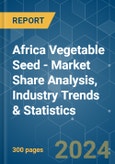The Africa Vegetable Seed Market size is estimated at USD 700.14 million in 2024, and is expected to reach USD 974.58 million by 2030, growing at a CAGR of 5.67% during the forecast period (2024-2030).
Key Highlights
- Solanaceae is the Largest Crop Family. It is the largest segment due to the growing local demand, during off-seasons, and the availability of high-yielding varieties has contributed to the market growth.
- South Africa is the Largest Country. It is the largest segment because of the increase in the cultivation area, increase in the adoption of protected cultivation and increase in the use of hybrid seeds.
- Roots & Bulbs is the Fastest-growing Crop Family. The fastest growth of the roots and bulbs is associated with the development of true seeds in case of potato and garlic, which is the emerging market in the future.
- Ethiopia is the Fastest-growing Country. It is the fastest-growing market due to favorable government policies. The government has set a ten-year economic development plan where the major focus is on the agriculture.
Africa Vegetable Seed Market Trends
Open Pollinated Varieties & Hybrid Derivatives is the largest Breeding Technology
- In Africa, open-pollinated varieties dominated the market in 2021, with a share of 70.6% of the total vegetable seed market, and hybrid vegetable seeds occupied a share of 29.4%. The need to increase vegetable production and yield is driving the African vegetable seed market.
- In terms of the value of hybrid seeds, the percentage of roots and bulbs is the highest, accounting for over 23.1% of the total market value of hybrid vegetable seeds in Africa. In terms of value share, tomato and onion were the two most significant vegetable crops, accounting for roughly 10.1% and 9.4% of the market for hybrid vegetable seeds, respectively.
- Solanaceous and cucurbits accounted for 30.5% of the market value for vegetable seeds in Africa in 2021. Chili has the largest seed market, accounting for a share of 12.7% of the market for open-pollinated vegetable seeds in 2021.
- In 2021, unclassified vegetables accounted for about 37% of the total area cultivated with open-pollinated varieties and hybrid derivatives in Africa. The crops included native types of asparagus, artichokes, and other vegetables.
- The market for hybrid seeds is primarily driven by the modernization of agriculture and the development of new products. The expansion of the organic farming area for vegetables in Africa is contributing to the growth of non-transgenic hybrids. The major players in the region are launching new products and making significant investments in R&D to create new varieties based on market demands.
- The open-pollinated vegetable seed market in Africa is estimated to grow by 2.6% during the forecast period due to the rising demand for native varieties and low input costs.
South Africa is the largest Country
- In 2021, vegetables held a minor share of the African seed market, accounting for 20.8% in terms of value. The cultivation area under vegetable production in Africa increased from 41 million ha in 2016 to 48 million ha in 2022, owing to the increase in the demand for vegetables, high return on investment, and new technologies.
- South Africa held the largest market share as of 2022 due to the high demand for vegetables by other countries, such as the Netherlands and China. In 2021, the major vegetable crops grown in the country were chili (15.7%), lettuce (13.7%), and pumpkin and squash (13.6%).
- Ethiopia has the fastest-growing seed market, with a CAGR of 4.0%. The increasing trend of protected cultivation due to the all-year-round availability of the crops is boosting the growth of the market. The share of vegetables under protected cultivation increased by 27.7% in 2021 from the previous year.
- In the protected cultivation segment, Africa accounts for less than 1% of the vegetable seed market. No support from the government for setting up new greenhouse structures, lack of technical support and skills, and limited access to investment funding are major obstacles to the adoption of protected cultivation techniques by African farmers.
- In Nigeria, the rising demand for fresh organic vegetables is driving the farmers to grow vegetables under organic farming. The area under organic farming was 52,420 ha in 2016, which increased to 54,995 ha in 2020, leading to the increased demand for vegetable seeds.
- Therefore, with the increase in demand for vegetables due to the increasing area under vegetable farming, the vegetable seed market is anticipated to grow by 2.9% during the forecast period.
Africa Vegetable Seed Industry Overview
The Africa Vegetable Seed Market is fragmented, with the top five companies occupying 30.58%. The major players in this market are Bayer AG, Bejo Zaden B.V., Groupe Limagrain, Rijk Zwaan Zaadteelt en Zaadhandel B.V. and Syngenta Group (sorted alphabetically).Additional Benefits:
- The market estimate (ME) sheet in Excel format
- 3 months of analyst support
Table of Contents
1 EXECUTIVE SUMMARY & KEY FINDINGS2 REPORT OFFERS7 KEY STRATEGIC QUESTIONS FOR SEEDS CEOS
3 INTRODUCTION
4 KEY INDUSTRY TRENDS
5 MARKET SEGMENTATION
6 COMPETITIVE LANDSCAPE
8 APPENDIX
Companies Mentioned (Partial List)
A selection of companies mentioned in this report includes, but is not limited to:
- BASF SE
- Bayer AG
- Bejo Zaden B.V.
- Enza Zaden
- Groupe Limagrain
- Rijk Zwaan Zaadteelt en Zaadhandel B.V.
- Sakata Seeds Corporation
- Syngenta Group
- Takii and Co.,Ltd.
- Zambia Seed Company Limited (Zamseed)
Methodology

LOADING...










